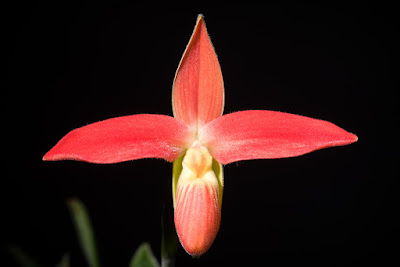Phragmipedium besseae is native to Ecuador and the area of San Martin in Peru. They grow at an altitude of 1100 m on partly shady, steep, eastern exhibition, damp riverside cliffs or moist granite rocks
Phragmipedium besseae also called as Mrs. Besse's Phragmipedium (named to honor the American Orchid Collector), Paphiopedilum besseae, Phragmipedium besseae var. flavum, is a species of the genus Phragmipedium. This species was described by Dodson & Kuhn in 1981.
IDENTIFY PHRAGMIPEDIUM BESSEAE
Phragmipedium besseae is native to Ecuador and the area of San Martin in Peru. In both locations, the plants grow at an altitude of 1100 m on partly shady, steep, eastern exhibition, damp riverside cliffs or moist granite rocks where they are exposed to the early morning sun. In Peru, they grow near Phragmipedium boisseranum, while in Ecuador, Phragmipedium besseae grows very close to the colony Phragmipedium schlimii.
It is a small sized, warm growing, lithophyte or terrestrial, which reaching 22 cm in height, with no pseudobulbs and 6 to 10, linear to narrowly elliptic, coriaceous, dark green, 15-25 cm long leaves in a broad fan shape.
Mrs. Besse's Phragmipedium blooms on a terminal, erect, 12 to 16" (30 to 40 cm) long, 1 to 4, successive flowered, pubescent, racemose inflorescence that is shorter than the leaves with elliptic, boat-shaped bracts occurring in the late winter and spring. The flowers are 4-6 cm in diameter and open successively. The petals and sepals are broadly elliptical, brightly crimson, which is closer to the core and turns into yellow. Fleecy, slippery lips resembling scarlet and yellow stripes. In the upper part of the lip is slightly wrinkled, along its edge there is a strip of yellow color.
PHRAGMIPEDIUM BESSEAE CARE AND CULTURE
Phragmipedium bessae is a difficult plant to grow. That problems arise due to the use of unsuitable substrate, hard water or inadequate chemical composition of fertilizers.
Light:
Phragmipedium besseae needs a light level of 12000-15000 lux, sometimes even in deep shade - 6000 lux. The light should be dispersed and direct sunlight should be avoided. The plants are healthier and that the growth of roots increases strongly when plants are provided with a 16-hour day throughout the year.
Temperature:
It is a thermophilic plant. The average temperature throughout the year is 26-27 ° C during the day and 15-17 ° C at night, giving a diurnal difference of 9-12 ° C.
Humidity:
Mrs. Besse's Phragmipedium needs the humidity of 80-90% throughout the year. The high humidity is very important for the health of the plant.
Substrate, growing media and repotting:
Phragmipedium besseae can grown in plastic pots with a traditional mix of fir bark and sphagnum moss. Repotting is best done in early spring, when the growth of new roots begins.
Watering:
The plants should be regularly watered, so that the substrate is constantly moist. These orchids grow in the moss on wet slopes, on the surface of which the water oozes, so even in a relatively dry period, the roots of the plants receive a sufficient amount of moisture.
Fertilizer:
If the live moss of sphagnum is not used as a substrate, then in the period of active growth every 1 or 2 weeks it is necessary to feed the plant with 1/4-1/2 of the usual fertilizer dose. Phragmipedium besseae has high nutritional requirements and that the color of the flowers improves when the right doses of fertilizers are used. An excellent fertilizer for these plants is dilute manure.
Rest period:
In winter, watering, humidity and fertilization can be limited, while the amount of light can be slightly increased in the number of cloudless days.















COMMENTS